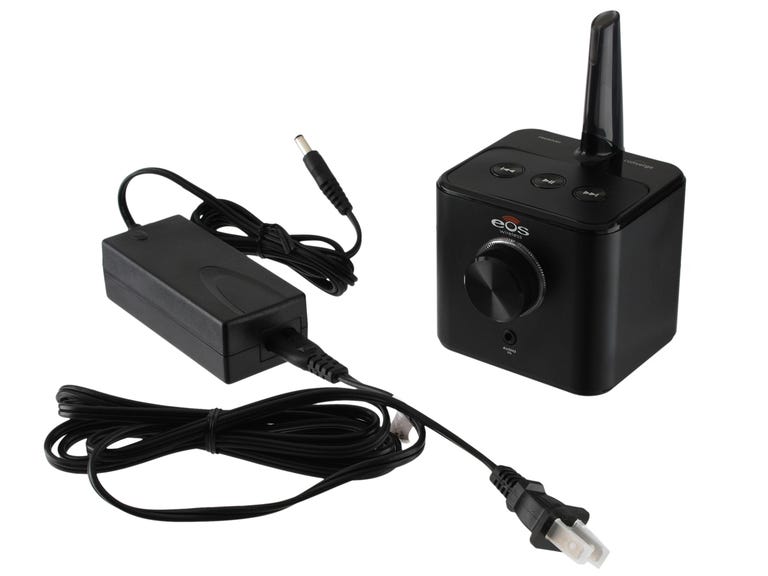 Why You Can Trust CNET
Why You Can Trust CNET Eos Converge Wireless Amplified Receiver review: Eos Converge Wireless Amplified Receiver
Eos Converge Wireless Amplified Receiver
After a CNET reader asked us to figure out how to get laptop audio streamed wirelessly to a receiver, we came across the Sound Blaster Wireless System for iTunes and Receiver. While the system worked well, we were disappointed to see that the included remote control was fully functional only with PCs. Just like with most devices, the 2.4GHz-dependent system also occasionally interfered with our Wi-Fi router.
The Good
The Bad
The Bottom Line
To even the playing field, we're now taking a look at the Eos Converge line of products, a group of devices that aim to accomplish the same basic function as the Sound Blaster system. The Converge is easier to set up, has a better range, but is much bulkier than the Creative offering.
Even though this is the review for the Wireless Amplified Receiver, we'll be discussing other components that must be present in order for the system to work. Eos offers four separate devices as a part of the Converge line, each one available for purchase by itself.
The Wireless Transmitter and "="">Wireless Receiver both retail for $100. You'll need at least these two products in order for your system to work, so it's safe to say you'll be spending a minimum of $200 on your Converge set up. Also available are the Amplified Receiver (for $150) and a set of bookshelf speakers (for use with the Amplified Receiver) for $100. The Eos Converge line can be mixed and matched according to your personal preference.
The Eos Converge Wireless Amplified Receiver is the bulkiest of all the product line's receivers, measuring 3 inches high by 3.5 inches wide by 3 inches deep.
The device feels solid and sturdy and has a rubber pad at the bottom to ensure it stays put. A 2.5-inch antenna rests atop the transmitter and will glow blue when connected with the transmitter.
Setting up the wireless system is simple. Using the included USB cable, you attach the device to an open port on your PC or Mac, desktop or laptop. The transmitter uses power from the USB port, so there's no separate power connection required. Also included with the Wireless Transmitter is a 1/8-inch patch audio cable to make use of the "audio out" port on the device.

You will need power for the Wireless Receiver (the standard and the amplified versions), so it can receive and then pass the signal along to your desired player. Unlike the standard receiver, you cannot turn it off when not in use.
We hooked our Wireless Amplified Receiver up to a stereo system using standard speaker wire (not included). Eos sells a proprietary pair of bookshelf speakers ($100), but the device will work with any nonpowered speakers; just make sure you use bare-stripped speaker wire, as that's all that will fit inside the clips. There is also a port for a subwoofer output, which worked well. We'd recommend a subwoofer that supports an adjustable volume, as the receiver cannot control that.
The receiver also has play/pause and skip forward and back buttons on top, which will work with iTunes and most other media players you have loaded on your computer. On the front of the receiver is a volume knob that will control the level of amplification, and an auxiliary-in port that can amplify any nonstreamable device that can plug into a headphone jack.
If your computer does not switch sound over to the transmitter automatically, you'll have to manually change this according to your operating system. Windows users can navigate to Control Panel > Sounds & Audio and select Eos; Mac users need to head to System Preferences and select Eos under the Sounds settings.
During our testing, we were impressed with the range at which the transmitter was able to broadcast. Eos claims a 150-foot range, and our testing definitely flirted with that measurement. Even better, the Eos was able to work through numerous walls and even two floors.
Like all devices that operate on the 2.4GHz spectrum, we did experience some interference with our wireless router. We recommend setting your router to a separate channel to avoid drops in performance.
Our major complaint with the Eos Converge system is that the transmitter is larger than we would have liked. Also, ideally, we would have liked to see a USB dongle (like we saw with the Sound Blaster), but the range would have suffered as a result.
The last problem we had with the Converge system is that it's missing a remote control. Even though the Sound Blaster system has limited Mac functionality with its remote, it does provide plenty of control when using a PC. The Sound Blaster can be had online for around $150, yet the Eos will cost you a minimum of $200.


